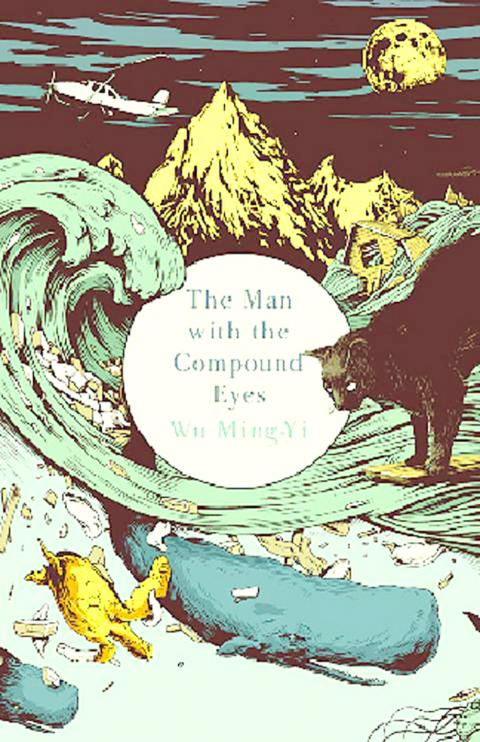Back in 2009, the New York Times published an article headlined “Recyclers, Scientists Probe Great Pacific Garbage Patch,” which noted that a group of scientists had “set sail from San Francisco Bay ... to study the planet’s largest known floating garbage dump, about 1,000 miles north of Hawaii.”
Fast forward to 2013: Taiwanese nature writer Wu Ming-yi (吳明益) has just released an English translation of his The Man with the Compound Eyes (複眼人) that’s aimed at an international readership. The 300-page novel, which has an eye-catching cover for the new British edition, is about that same floating dump.
Wu started writing the novel in 2006 when he read about the floating trash vortex in Chinese-language newspapers. As novelists often do, he concocted a “vision” based on the vortex: An Aboriginal teenager from the imaginary island of Wayo Wayo rides this garbage island and washes up with it one day on the east coast of Taiwan. In the ensuing chaos, the Taiwanese print and TV media have a field day reporting this ecological calamity, and Taiwan — the story is set in the near future of 2020 — is never the same.

In many ways, The Man with the Compound Eyes is a Pacific novel, about a Pacific Islander identity that differs in many ways from the commonplace Han Chinese-centric novels that are published in Taiwan.
The novel stars the boy from Wayo Wayo and a middle-aged Taiwanese college professor named Alice, both of whom are thrown into Taiwan’s east coast wilderness in a search for some lost hikers -- and enlightenment. There’s a cast of characters that expats will know well from their travels along the east coast, and Wu plots the story in very Taiwanese terms. (The English translation by Canadian expat Darryl Sterk, a professor at National Taiwan University, is superb and sensitively captures the nuances of Taiwan’s Aboriginal cultures and languages.)
Wu’s rollercoaster of a story is about wilderness, wildness, wonderment, love. It’s also about “massage parlors” along the east coast where tired and drunk soldiers go for rest and relaxation, with mini-lessons thrown in about various aspects of Aboriginal culture and food.
For readers in Taiwan who have been here for a number of years and know the east coast well, Wu’s novel is sure to strike a chord. But just how this Pacific novel will do overseas with readers in Europe and North America who know little about Taiwan or the Aboriginal cultures here remains to be seen.
As a longtime expat in Taiwan, I read the novel as a critique of modern society’s disregard for our planet’s ecology and environment — a wake-up call, in other words, for Taiwan and the rest of the world.
Readers overseas might find Wu’s story merely a pleasant diversion from the daily grind. You may not have to know much about Taiwan or insect eye biology to enjoy The Man with the Compound Eyes, and the mid-book chapters about that reveal the mystery behind the man with the compound eyes are perhaps the best writing to ever come out of a Taiwan novel. Some readers have drawn comparisons between the novel and Yann Martel’s Life of Pi. Yes, it’s that kind of book, and it would make that kind of movie, too.
Wu’s work began its literary life as a mostly-neglected, unheralded Chinese-language novel in 2011. Taiwan’s Ministry of Culture and the National Museum of Taiwan Literature (國立台灣文學館) used their resources and contacts to help set the book on its way to translation and overseas publication.
Published by Harvill Secker in London last month, the book will be released in New York in 2014, with a French edition as well. The US edition of the book, for reasons that only publishing and marketing industry executives know for sure, will not be released until next year. Readers in Taiwan and elsewhere who want to order the book can use the British Amazon Web site to purchase the UK edition.
Once I started reading this edition, I couldn’t put it down, and over the course of several days I felt that I had ventured into a new, uncharted territory concocted by a Taipei visionary. Part South American magical realism, part Margaret Atwood rollercoaster of the imagination, The Man with the Compound Eyes is a wild story that’s been mashed up into art, and you don’t need compound eyes to appreciate its unique vision.

The Taipei Times last week reported that the rising share of seniors in the population is reshaping the nation’s housing markets. According to data from the Ministry of the Interior, about 850,000 residences were occupied by elderly people in the first quarter, including 655,000 that housed only one resident. H&B Realty chief researcher Jessica Hsu (徐佳馨), quoted in the article, said that there is rising demand for elderly-friendly housing, including units with elevators, barrier-free layouts and proximity to healthcare services. Hsu and others cited in the article highlighted the changing family residential dynamics, as children no longer live with parents,

It is jarring how differently Taiwan’s politics is portrayed in the international press compared to the local Chinese-language press. Viewed from abroad, Taiwan is seen as a geopolitical hotspot, or “The Most Dangerous Place on Earth,” as the Economist once blazoned across their cover. Meanwhile, tasked with facing down those existential threats, Taiwan’s leaders are dying their hair pink. These include former president Tsai Ing-wen (蔡英文), Vice President Hsiao Bi-khim (蕭美琴) and Kaohsiung Mayor Chen Chi-mai (陳其邁), among others. They are demonstrating what big fans they are of South Korean K-pop sensations Blackpink ahead of their concerts this weekend in Kaohsiung.

Oct 20 to Oct 26 After a day of fighting, the Japanese Army’s Second Division was resting when a curious delegation of two Scotsmen and 19 Taiwanese approached their camp. It was Oct. 20, 1895, and the troops had reached Taiye Village (太爺庄) in today’s Hunei District (湖內), Kaohsiung, just 10km away from their final target of Tainan. Led by Presbyterian missionaries Thomas Barclay and Duncan Ferguson, the group informed the Japanese that resistance leader Liu Yung-fu (劉永福) had fled to China the previous night, leaving his Black Flag Army fighters behind and the city in chaos. On behalf of the

I was 10 when I read an article in the local paper about the Air Guitar World Championships, which take place every year in my home town of Oulu, Finland. My parents had helped out at the very first contest back in 1996 — my mum gave out fliers, my dad sorted the music. Since then, national championships have been held all across the world, with the winners assembling in Oulu every summer. At the time, I asked my parents if I could compete. At first they were hesitant; the event was in a bar, and there would be a lot